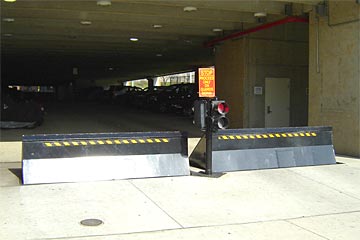Excitement About Wedge Barriers
The Ultimate Guide To Wedge Barriers
Table of ContentsAbout Wedge BarriersThe Wedge Barriers Statements


18 may be done quicker, quickly, and expense successfully. FIG. In specific embodiments, the anchor 30 might be a steel framework including plates, beams(e. g., I-beams ), and/or other structures that are safeguarded within the foundation 14, which might be concrete. At the surface area 12, a top side 28 of the anchor 30 may go to least partially subjected
, thereby allowing the accessory of the barrier 10 to the anchor 30. g., threaded holes)in several light beams or plates of the anchor 30 might be subjected to the surface area 12. In this way, bolts 32 or various other mechanical bolts may be made use of to secure the obstacle 10 to the anchor 30. As the obstacle 10 is placed to the surface area 12 of the foundation 14, collection of debris and other material under the barrier might be reduced, and elements of the bather 10 might not be exposed to below grade settings. As shown by reference numeral 52, the training device 50 includes elements got rid of under the wedge plate 16. For example, the parts 52 below the wedge plate 16 might consist of an electromechanical actuator, a cam, one or even more webcam surface areas, and so forth. Additionally, the training device 50 includes a springtime assembly 54
The spring pole 58 is paired to a camera(e. g., camera 80 displayed in FIG. 4) of the lifting mechanism 50. The springs 60 disposed concerning the spring rod 58 are kept in compression by spring sustains 62, including a dealt with spring support 64. That is, the set springtime assistance 64 is dealt with family member to the foundation 14 and the remainder of the bather 10.
The Basic Principles Of Wedge Barriers
g., spring support 65 )might be taken care of to completion of the spring rod 58 to make it possible for compression of the springtimes 60. As the springs 60 are pressed in between the springtime sustains 62, the springtime setting up 54 creates a force acting upon the camera coupled to the springtime pole 58 in an instructions 66. The staying pressure applied to
the cam to deploy release wedge plate 16 may might provided offered an electromechanical actuator 84 or other various other. The spring setting up 54 and the actuator 84(e. g., electromechanical actuator)may operate with each other to convert the webcam and raise the wedge plate 16.
As discussed over, the spring setting up 54 exerts a constant pressure on the camera, while the electromechanical actuator may be regulated to exert a variable force on the web cam, therefore making it possible for the lifting and reducing( i. e., releasing and pulling back )of the wedge plate 16. In certain embodiments, the constant force used by the springtime setting up 54 might be adjustable. g., electromechanical actuator) is handicapped. As will certainly be Go Here appreciated, the spring assembly Web Site 54 may be covered and shielded from debris or other elements by a cover plate(e. g., cover plate 68 displayed in FIG. 4) that might be substantially flush with the raised surface 38 of the structure 14. As stated above, in the deployed setting, the wedge plate 16 offers to obstruct gain access to or traveling beyond the obstacle 10. The barrier 10(e. g., the wedge plate 16 )might obstruct pedestrians or vehicles from accessing a residential property or pathway. As gone over above, the obstacle 10 is affixed to the anchor 30 secured within the structure 14,

front brackets 71. Consequently, the linkage assemblies 72 might pivot and rotate to allow the collapse and expansion of the linkage settings up 72 throughout retraction and deployment of the bather 10. The link settings up 72 cause activity of the wedge plate 16 to be restricted. For example, if a vehicle is traveling towards the released wedge plate 16(e. For instance, in one situation, the security legs 86 may be prolonged duringupkeep of the barrier 10. When the safety legs 86 are deployed, the safety legs 86 sustain the weight of the wedge plate 16 against the surface 12. As an outcome, the training device 50 may be deactivated, serviced, gotten rid of, changed, and so forth. FIG. 5 is partial viewpoint sight of a personification of the surface-mounted wedge-style barrier 10, illustrating the camera 80 and the cam surfaces 82 of the training device 50. Specifically, two webcam surface areas 82, which are referred to as lower camera surface areas 83, are positioned listed below the cam 80. The reduced webcam surface areas 83 might be repaired to the surface 12 (e. As an example, the reduced camera surfaces 83 and the mounting plate 85 might create a single piece that is safeguarded to the support 30 by bolts or other mechanical bolts. In addition, 2 camera surfaces 82, which are referred to as upper web cam surface areas 87, are placed over the web cam 80 and paired to (e. In other embodiments, stepping in layers or plates may be positioned between the surface area 12 and the reduced webcam surfaces 83 and/or the wedge plate 16 and the upper cam surface areas 87 As mentioned above, the webcam
80 equates along the web cam Learn More Here surfaces 82 when the wedge plate 16 is raised from the retracted position to the deployed position. Additionally, as stated above, the springtime setting up 54 (see FIG. 3 )may offer a force acting on the cam 80 in the direction 102 via springtime pole 58, which may lower the force the electromechanical actuator 84 is needed to put on the cam 80 in order to activate and lift the wedge plate 16. 1 )to the released position(see FIG. 4). As shown, the cam 80 consists of track wheels 104(e. g., rollers), which contact and equate along the webcam surface areas 82 during procedure.